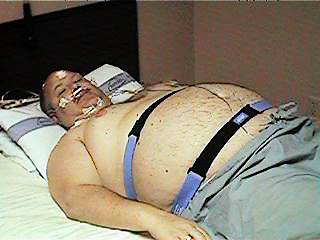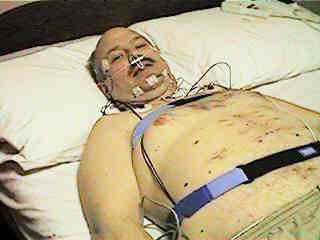

After an initial appointment with the Doctor in charge of the Sleep Disorders Lab I was given a date for the sleep study. I arrived as scheduled and one of the staff proceeded to attach electrodes all over my head, face and chest. This made me think about John Luc Picard of Star Trek Next Generation when he was assimilated by the Borg. Part man part machine, this is the stuff movies are made of.
The actual happenings were unknown to me --- I was asleep! But afterwards I was allowed to view a video taken of me while I slept. Boy was that an eye opener! Tossing and turning, jerking and making loud snorting sounds. The technician reveled to me that during my sleep I stopped breathing 175 times. This resulted in a burst of muscle movement that would wake me up enough to start breathing again. As explained by the doctor I was going through the night without restful sleep, instead I was fighting for life. This fight would leave me exhausted when I finally got up in the morning rather than being rested.
Now I sleep with a CPAP machine and as a result I sleep better. The machine prevents my air way from closing. That way I get to sleep quietly and restfully. No stop breathing episodes = Life.
The next step is to have a filter inserted into the Inferior Vena Cava below my heart...
This is a copy of the report from my visit to the sleep lab. This report was sent to my Insurance Company and I have had no problem with them asking for more information or failure to pay.
Document ONE:
Patient: Daryl G. Davidson
Age: 42
Date: 9/9/98
Physician: Robert n. Aguillard, MD
Category: Outpatient
History:
This 42-year-old, obese, white male, nonsmoker, had an overnight sleep study performed in 1992, at Baptist Memorial Hospital. He was placed on nasal CPAP. Over the last six or seven weeks, he has developed increasing problems going to sleep at night. He had a followup overnight sleep study performed at some point at Baptist Memorial Hospital and also had problems initiating sleep. He normally attempts to retire around 10:00 PM. He often will lie in bed awake until around 4:00 in the morning. he gets up at 6:30 in the morning. He does not feel refreshed. He is sleepy throughout the day. He has gained over 100 pounds since his initial sleep study. He does have snoring when he is using his nasal CPAP machine which began six or seven weeks ago. He has taken Melatonin. He notes that when he takes Melatonin approximately one hour before going to sleep he is drowsy the next day. His medications include Atenolol, Prinzide/hydrochlorothiazide, Glucotrol, Rezulin, Wellbutrin, Buspar, Relafen, Risperdal, and Zocor.
Past Medical History:
Past medical history is significant for non-insulin-dependent diabetes mellitus, hypertension, depression. He has no history of know heart disease. He did have a uvulopalatopharyngoplasty performed in the past.
Social History:
He does not smoke or drink. He works as an administrator at Millington Medical Clinic. He lives with his wife.
Family History:
Family history reveals his mother's brothers as well as his mother have sleep apnea.
Review of Systems:
Review of systems is otherwise negative.
Physical Examination:
He is an obese, white male. On HEENT exam, his tympanic membranes are clear bilaterally. He has patent nares. He has absence of a uvula. On chest exam, he has a regular rhythm without murmur, gallop, or rub. On ausculation of his lungs, he has no wheezes, rales, or rhonchi. Extremities show 1 - 2 + pretibial and pedal pitting edema.
Impression:
1. Obstructive apnea syndrome (1.A.8.) that is currently being treated with nasal continuous positive airway pressure.
2. Snoring. (2.D.6.)
3. New onset of difficulty initiating sleep.
4. Multiple medical problems including Diabetes mellitus, hypertension, and depression.
Recommendations:
1. Melatonin 4 mg to 5 mg before going to sleep at night at approximately 6:00 in the evening.
2. Followup overnight sleep study for retitration of his nasal CPAP.
Patient: Daryl G. Davidson
Age: 42
Physician: Robert N. Aguillard, MD
Procedure: Overnight Polysomnography - Night 1 of 1
Category: Outpatient
Interpretation:
This is night one. He had a total time in bed of 6 hours and 50 minutes. His total sleep time was 5 hours and 18 minutes for a sleep efficiency index of 76.2%. He had 13.5 minutes of stage 1 which is 3.4% of total sleep time. He had 207.0 minutes of stage 2 sleep which is 51.6% of total sleep time. He had 66.0 minutes of stage 3/4 sleep which is 16.5% of total sleep time. He had 31.5 minutes of REM (rapid eye movement) sleep which is 7.9% of total sleep time. His sleep onset latency was 7.5 minutes. His REM onset latency was 131.5 minutes. He had 26 awakenings. He had a total of 11 apneas of which 3 were central, 7 were obstructive, and 1 was mixed. He had 69 hyponeas, 274 myoclonic events, and 217 myoclonic events with arousals. His longest apneic event lasted 90 seconds. His lowest oxygen saturation was 85%. His apnea index and apnea arousal index were both 2.1/hour. His hypopnea index and hypopnea arousal index were both 13.0 /hour. His apnea/hypopnea index was 15.1/hour. His myoclonus index was 51.7/hour. His myoclonus arousal index was 40.9/hour. He was started on 9 cm nasal CPAP. He had some obstructive apneas. It was then increased to 11 cm. It was subsequently to 13 cm. Spontaneous arousals were present regardless of nasal CPAP level with chin electromyographic elevation. Nocturnal myoclonus was present. Alpha intrusion as well as sleep spindles were noted in non-REM sleep stages. He had several awakenings after sleep onset. Overall, he had a loss of REM sleep and an excessive amount of awake time.
Impressions:
1. Obstructive sleep apnea (1.A.8.) that is probably adequately treated with 11 cm nasal continuous positive airway pressure.
2. Snoring. (2.D.6.)
3. Frequent spontaneous arousals regardless of nasal continuous positive airway pressure level with chin electromyographic elevation.
4. Nocturnal myoclonus the first one-half of the night. This may not be his primary sleep problem and may improve with continued nasal continuous positive airway pressure treatment.
5. Some difficulty maintaining sleep as well as increased number of sleep spindles and alpha intrusion, some of which may be due to medication.
6. New onset of difficulty initiating sleep.
7. Status post uvulopalatopharyngoplasty.
8. Multiple medical problems including diabetes mellitus, hypertension, and depression. Hypertension can be worsened by the presence of apnea.
Recommendations:
1. Nasal CPAP (continuous positive airway pressure) at a setting of 11 cm while sleeping.
2. Increase nasal CPAP to 13 cm if he continues to complain of daytime sleepiness as well as snoring.
3. Continue the use of 6:00 PM dosing of Melatonin before going to sleep at night.
4. Followup with me in one year, earlier if he continues to have daytime sleepiness and snoring.
Patient: Daryl G. Davidson
Date: 10/7/98
Impression:
1. Obstructive sleep apnea - probably adequately treated with 11 cm nCPAP.
2. Snoring.
3. Frequent spontaneous arousals regardless of nCPAP level with chin EMG elevation.
4. PLMD's first half of night.
5. DMS; increased spindles and alpha- some due to medications?
6. New onset of DIS.
7. Multiple medical problems.
8. S/P UP3
Recommendations:
1. 11 cm nCPAP- increase to 13 if not better?
2. Continue 6:00 PM Melatonin dosing?

|
NEXT: Anesthesia and the Sleep Apnea Patient Return to my Home Page |